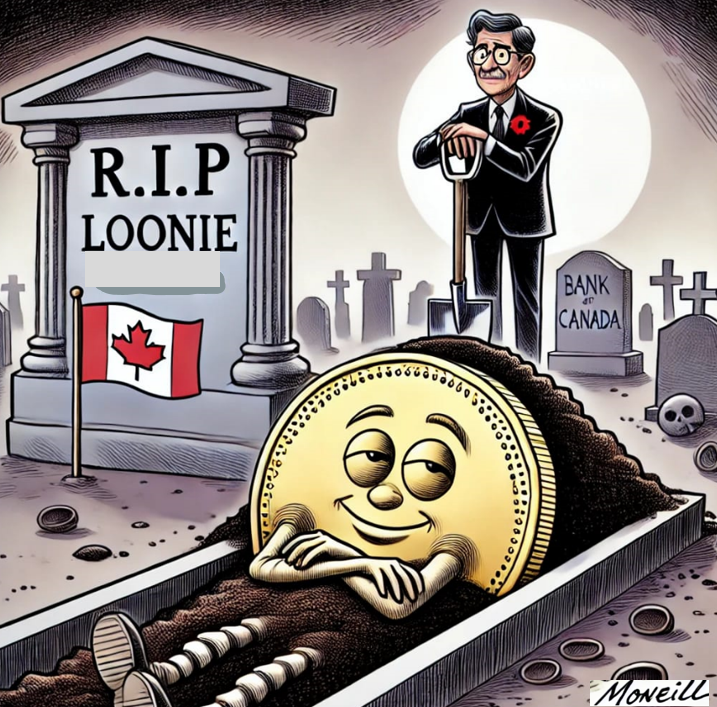
By Michael O’Neill
The Bank of Canada served up what many are describing as a “super-sized” rate cut after policymakers cut the benchmark rate by 50 bps to 3.75%. It’s a nice move, but hardly super-sized. During the Covid era, the BoC, raised rates by 50, 75,and 100 bps in successive moves. Arguably, only the latter bump is “super-size.”
Governor Tiff Macklem justified the move by pointing out that inflation has fallen to 1.6% y/y, and the Canadian economy is still in excess supply. The BoC estimates the output gap is negative, between -0.75% and -1.75%, which is actually a rather hokey number. It is not quantifiable, but a guess based on economic modeling. You may recall that Mr. Macklem blamed “inaccurate forecasting models” for why the BoC failed to recognize the persistence of post-Covid inflation. Why would his output gap model be any better? Just saying.
Cut to the Chase.
The Monetary Policy Report is a 10,751-page saga that essentially boils down to ‘Buckle up, folks, the economy’s still going down hill and we’re all pretending we have control.” The BoC knows this and is predicting weaker Q3 GDP (actual1.5% compared to 2.0% growth in H2). Canadian consumers are not spending the way their American counterparts are, and Canada’s export driven economy may be facing major headwinds in 2025.
What Happened to the Lag Effect.
The 50 bp rate cut is the fourth since June. But why 50 bp this time? What happened to the so-called “lag effect”?
Governor Macklem has spoken frequently about the delayed impact of rate changes. Since 2022, he’s reminded us that it takes time for these adjustments to fully filter through the economy and affect inflation and growth. Rate hikes, he’s stressed, can take anywhere from 12 to 18 months to show their full impact on consumer spending and business investment.
So why the sudden urgency for another cut? It suggests policymakers might believe the economy is in worse shape than their models are predicting, which is not a problem for the Fed.
US Economic Outlook Is Robust
The US is Canada’s largest trading partner by a long shot. The International Monetary Fund is predicting American GDP growth around 1.9% while Canada is expected to grow 2.1% (source: Table A2 WEO-October). That seems rather dubious. The US economy is robust and diversified. Canada-not so much. In addition, Canada’s GDP per person is shrinking, while employment cannot keep pace with rising immigration. It gets worse, geopolitical tensions are elevated and show no signs of abating. China has stepped up its intimidation of Taiwan, North Korea is supplying troops and ammunition to Russia, and Israel is on the brink of all-out war with Iran. When the traders get spooked, they buy US dollars. And we may not have heard the last of Trump.
Tariff-Man, the Sequel

Former President Donald Trump is looking more and more like the future President Trump, and he is deeply in love with tariffs. He said as much during his campaign, describing tariff as the most beautiful word in the dictionary. He is promising a minimum of 10% levies on all imports into the US and another 60% on Chinese imports. His policies may be harmful to the American economy but would be very detrimental to Canada.
A surge in tariffs of Canadian exports to the US would trigger higher unemployment and a jump in inflation. Sure Canada would respond in kind, but in a trade war with the US, Canada would not fare much better than Hezbollah operatives when they responded to pager beeps on September 17.
Throw Another Shovelful In
The Bank of Canada is on the rate cut bandwagon and analysts are predicting another 50 bp rate cut at the December 11 meeting and a series of additional cuts that will take the benchmark rate to 2.5%. They believe inflation risks are balanced and are not overly concerned about the weak economy, weaker job market, and the ongoing productivity slump. That view is throwing dirt into the Loonie’s grave.
The Fed does not have to deal with a weak economy or a weak employment market. The S&P 500 is up over 21.0% year-to-date and to quote Fed Chair Jerome Powell “this isn’t a Committee in a hurry to cut rates.” That suggests USDCAD downside is limited to the 1.3700 area while increasing the odds for a move to 1.4100.
Rest in Peace, Loonie, it was nice knowing you.





